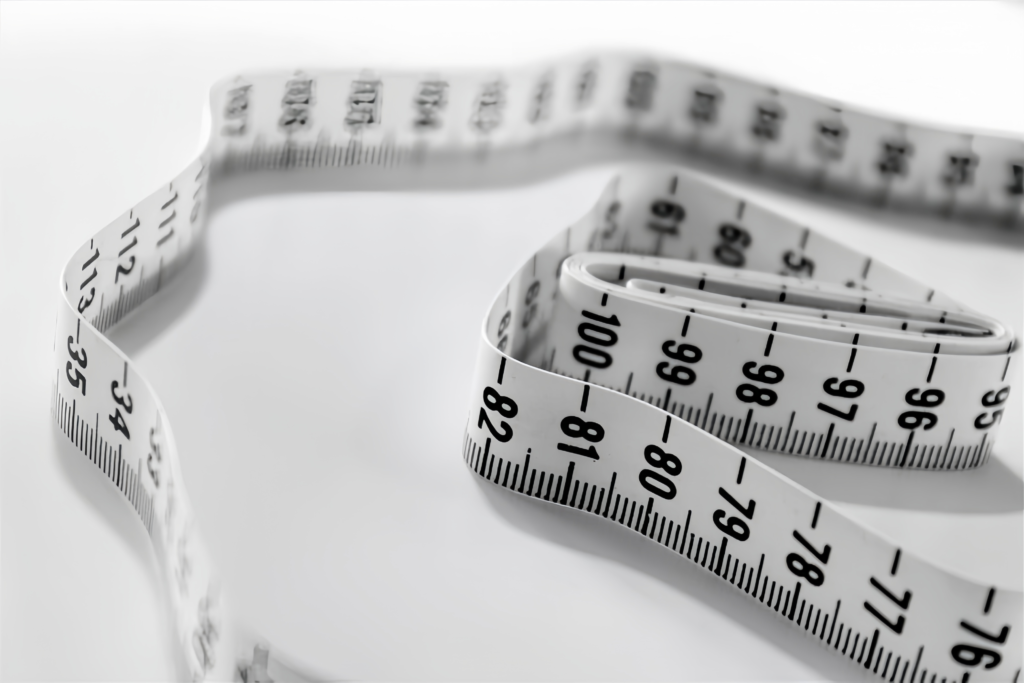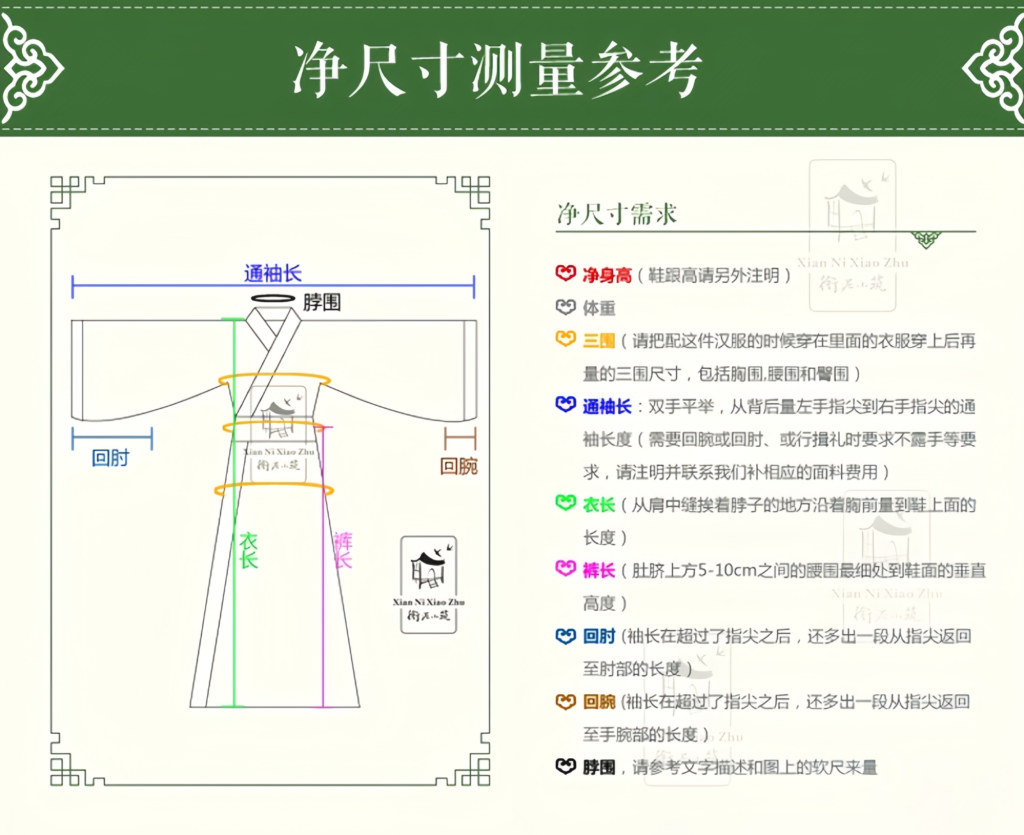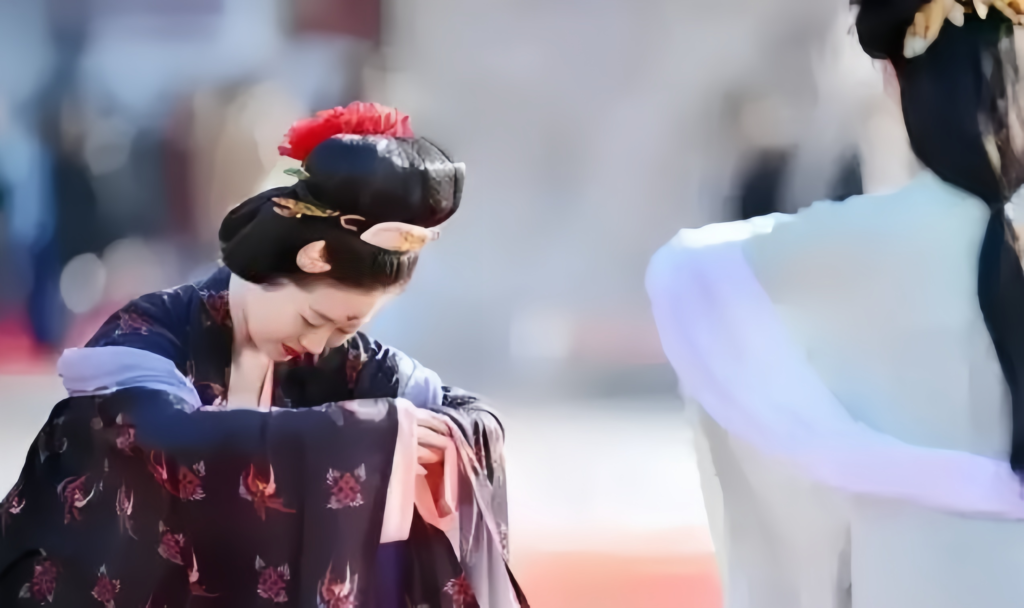Hanfu Sizing Guide: 5 Tips for the Right Fit for Your Hanfu

Hey there! I’ve received a lot of questions on my Hanfu server about Hanfu sizing, so I wanted to take a moment to break down some common Hanfu measurements and sizing tips. I’ve gathered the most essential ones, which you’ll often see in size charts or when designers are creating patterns. I hope this helps as a useful reference! If you have any questions, feel free to reach out!
Hanfu Sizing Guide
Body Measurements

Let’s start by looking at the basic measurements of your body.
- Height – This is the measurement from the top of your head to your feet, usually in centimeters (cm). If you’re not familiar with other units, this is the one you’ll see most often.
- Weight – Measured in kilograms (kg) or pounds (lbs). While this is useful, I’d suggest not relying solely on it since everyone has different body densities.
- Bust, Waist, and Hips – These are the three primary areas we measure for more detailed sizing.
- Bust – The circumference around the fullest part of your chest. Make sure to keep breathing comfortably while measuring. If you see this number on a size chart, it often refers to the garment’s measurement, so always select a size a few centimeters larger than your actual bust to avoid it being too tight. If the chart says “fits,” then you can match it to your own measurements directly.
- Waist – The measurement around the narrowest part of your torso, typically around the navel. Hanfu tends to have a high-waisted design, so keep that in mind!
- Hips – Measure around the fullest part of your hips (near the hipbones). If your hips are wider than average, estimate slightly higher, but don’t worry too much because Hanfu skirts don’t hug your hips tightly. The difference is usually minor.
Hanfu Measurements

Now let’s dive into the specific Hanfu sizing for different parts of a Hanfu. Some of these are pretty standard, while others are unique to Hanfu design.
- Top or Full-length Robe
- Length – This is the measurement from the collar to the hem. For tops, it’s the distance from your neck to the bottom of the garment. For robes or full-body garments, it’s the same concept. Skirts usually don’t have this measurement (see “skirt length” below). Keep in mind, the garment will hang from your shoulders, so the actual length you wear may feel a bit shorter.
- Sleeve Length – This measures from one sleeve edge to the other, when the garment is laid flat. Generally, this should be a little longer than your fingertip-to-fingertip measurement.
- Sleeve Opening / Width – This is the width of the sleeve at the wrist, but it can vary depending on the style of the sleeve. If you see the word “circumference,” this means it’s the measurement around the sleeve’s opening, so you’ll need to double the number. If it’s just listed as the width, it’s likely a measurement from the top to the bottom of the sleeve.
- Sleeve Root – This refers to the width of the sleeve where it attaches to the body of the garment. It’s an important measurement, especially when designing Hanfu because the sleeves are often made from a different piece of fabric than the body of the garment.
- Neckline Width – This is the width of the collar, usually ranging from 4 to 8 cm depending on the style. It’s the gap at the back of the garment where the two sides meet and fold over to form the front opening.
- Skirt or Pants
(For pants, simply replace the word “skirt” with “裤” to switch between the two.) - Skirt Length – This is the measurement from the waist to the hem of the skirt. Sometimes it’s indicated whether it includes the waistband (“裙头”) or not. If no special note is made, the length typically includes the waistband.
- Waistband Width (裙头) – This refers to the width of the waistband, which is usually about 6 to 8 cm wide. Sometimes this is listed separately, but not always.
- Skirt Width – This is the overall width of the skirt, usually about 1.5 times the ideal waist circumference. This extra width gives your waist more freedom of movement. If there are holes for a waistband to go through, the measurement is usually the same as your waist circumference. If your waist is at least 10 cm smaller than this, that’s totally fine.
Glossary of Terms
For those of you looking to decode the weird and wonderful language of Hanfu sizing, here’s a quick glossary:
- 衣 (Yī) – Clothing, typically referring to tops or robes.
- 裙 (Qún) – Skirt (sometimes mistakenly written as “群”).
- 裙头 (Qún tóu) – Waistband or skirt head.
- 领 (Lǐng) – Collar or neck.
- 裤 (Kù) – Pants.
- 袖 (Xiù) – Sleeve.
- 围 (Wéi) – Circumference.
- 宽 (Kuān) – Width.
- 长 (Cháng) – Length.
- 圈 (Quān) – Around or to circle.
- 身 (Shēn) – Body.
- 合适 (Hé shì) – Fit or suitable (matches body measurements).
I hope this guide helps clarify some of the key measurements and terms used in Hanfu sizing. Understanding Hanfu measurements is crucial when shopping for your perfect fit. It’s always a good idea to measure yourself carefully and compare those numbers with a Hanfu fitting guide or size chart before buying a Hanfu, since sizing can vary by brand and design. If you’re unsure about anything or need more help with Hanfu sizing, feel free to ask! Happy shopping and dressing!
For more tips on how to choose the perfect Hanfu, visit this.





Responses